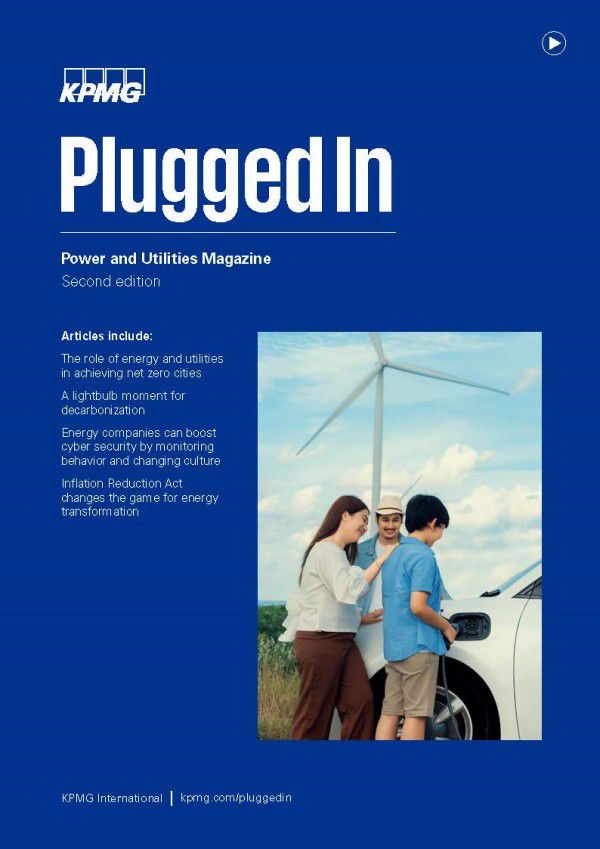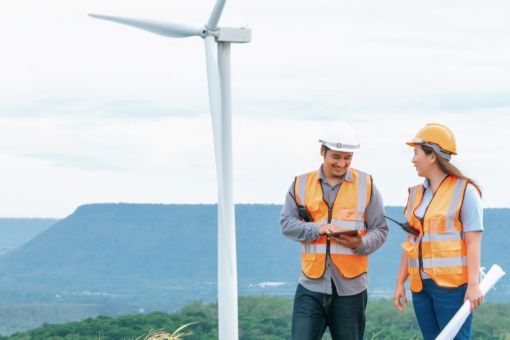Humanity’s road to net zero emissions runs through the city. More than half of us live in urban areas, a proportion expected to rise to two-thirds by 2050.1 While cities only occupy 3 percent of the Earth’s land area2, they produce more than three-quarters of greenhouse gas emissions and use more than three-quarters of natural resources.3 But cities are also centers of government and business, which have always had the ability to innovate and change. Using these abilities, cities can lead the rest of the world towards net zero.
In November 2022, KPMG launched the Net Zero Urban Program (NZUP) at COP27 climate change summit in Egypt. “We believe we have a societal role in helping our networks to convene, to connect, to partner with others, others who are equally as passionate as we are about accelerating climate action,” John McCalla-Leacy, Head of Global ESG, KPMG International and Head of ESG, KPMG in the UK, told an audience at an UN Climate Change Global Innovation Hub event where KPMG launched the program. NZUP aims to match digital technologies with capital to reach 10,000 cities, scale up 100 digital enabler prototypes and raise US$25 billion in capital by 2030.


We believe we have a societal role in helping our networks to convene, to connect, to partner with others, others who are equally as passionate as we are about accelerating climate action

John McCalla-Leacy
Head of Global ESG, KPMG International and Head of ESG
KPMG in the UK
Head of Global ESG, KPMG International and Head of ESG
KPMG in the UK
Opportunities for energy and utility companies
Cities tend to be more densely populated and are (bold) important asset and investment portfolios (/bold), which makes them ideal for experimentation and demonstration of decarbonization projects relying on efficient and flexible utility networks. Energy and utilities have a critical role in helping cities achieve net zero. They can develop products and services that will reshape future markets by leveraging urban ecosystems. This is particularly important given that utilities should consider investments that last for decades since today's projects and investments will likely run until and beyond 2050. As they embrace a low-carbon future, invest in innovation, and partner with communities, they can help cities create a sustainable future and achieve their company’s net zero goals.

Plugged In
The role of energy organizations in combating climate change
Download magazine (2.46 MB) ⤓

As cities move to net zero, energy companies have the best opportunity to contribute to this goal by providing them with decarbonized energy solutions. Several alternative energy sources are available to replace fossil fuels, including renewables, heat networks, hydrogen, and nuclear power. As a cost-effective and faster way to build a nuclear reactor, small modular reactors can help replace coal-fired power plants. By modernizing their infrastructure, energy companies can help their customers become more energy efficient and waste less.
Some energy companies have already committed to significant changes. US provider Xcel Energy has announced a series of decarbonization targets covering electricity, transport and natural gas, to be achieved partly through hydrogen and renewable natural gas. In November 2021, it set an overall aim of becoming a net zero energy company by 2050, with interim goals for reductions, including an 80 percent cut in natural gas emissions by 2030.4 Los Angeles aims to use only renewable energy by 2045 while electrifying its buildings and transportation. Los Angeles Water and Power is collaborating with the National Renewable Energy Laboratory on a scientific-based project that would fulfill this goal while also improving the environment, health, and socioeconomics.5
As part of its sustainability plan, CPFL Energia in Brazil has invested in energy-efficient hospitals and low-income communities and made its operations digitally operated and sustainable. Around 200 hospitals are being supported with solar panels and low-energy LED lighting, while low-income communities are receiving low-energy lightbulbs, heat exchangers, and solar heaters.6
With the hydrogen transition underway, companies around the globe are rethinking how they transport, distribute, and store hydrogen. Moreover, they are researching how to make energy production more sustainable, including the fuel sources used for electrolysis and the mix of fuels. Today, hydrogen investments are primarily focused on port and industrial sectors,7 although hydrogen-powered vehicles are also being tested in urban environments.
To reduce the sector's carbon footprint, the National Hydroelectric Power Corporation in India has signed two agreements to pilot green hydrogen technologies in Ladakh. In addition to developing a roadmap for future development of green hydrogen and reducing carbon emissions.8 These two pilot projects should also provide local youth with long-term opportunities for employment in the hydrogen economy.9
A European Union program called Important Projects of Common European Interest (IPCEI) supports key strategic technologies and projects, such as hydrogen and battery production.10 As part of a clean hydrogen program by Mission Innovation, the end-to-end costs of producing clean hydrogen are expected to be reduced to a tipping point of two dollars per kilogram by 2030.11 Through these programs, funding and other resources are provided to promote the development and deployment of technologies to accelerate the EU’s transition to a low-carbon economy.

Water utilities can improve the energy efficiency of their equipment and promote water conservation through education and incentives for more efficient use. They also have opportunities to generate energy and become more efficient. In January 2023, UK water utility Thames Water and KPMG in the UK published research on how heat in wastewater, such as from showers and washing machines, could be recovered and used in city heat networks, a technique already used at more than 500 locations worldwide.12 For example, 95 percent of all properties in the city of Uppsala are supplied by district heating, including since 1981 heat recovered from treated wastewater.13 The research found that Thames Water, which provides water to and takes wastewater from 15 million customers in London and southeast England, could supply around one million homes with heating and hot water based on wastewater heat recovery.

Waste management utilities can upgrade or retrofit their vehicle fleets to cut emissions and work to reduce waste and increase recycling through customer education and new circular economy business models. They can recover energy from waste through anaerobic digestion, where organic matter breaks down in a sealed oxygen-free vessel to produce biogas and fertilizer. France-headquartered water and waste utility Suez calculated it avoided greenhouse gas emissions equivalent to 3.8 million tons of carbon dioxide in 2021 through energy-from-waste and material recovery across its global operations.14
In the US, the Solid Waste Authority of Central Ohio and partners have established ‘Save more than food’, an awareness campaign that aims to contribute to the authority’s goal of halving food waste in the area by 2030 by encouraging people firstly to prevent food waste, then donate it where possible, then recycle it as animal feed, compost or for industrial use rather than sending any to landfill.15
As part of its zero-waste program, Pune Municipal Corporation (PMC) in India has developed solutions with SWaCH waste pickers for handling wet garbage, including composting and modular biogas, which reduces landfill methane emissions by reducing organic waste thrown into landfills and collecting e-waste and directing valuable materials to the recycling chain, thereby reducing the quantities of waste.16
Energy, waste, and water management should be considered critical components of cities' efforts to achieve net zero energy. Their use and provision of data will be crucial in helping to balance systems by steering supply and demand. This could be done by ensuring continuity for essential activities, including transport and healthcare. Achieving net zero also depends on utilities working together, such as water companies requiring decarbonized electricity.
Case study: the European Union
Several policies and initiatives are being implemented by the European Union (EU) to achieve the region's decarbonization and climate goals. One of the initiatives under the EU Green Deal requires the EU to generate 32% of its energy from renewable sources by 2030 as a roadmap for becoming climate-neutral by 2050.17 The EU Taxonomy defines sustainable economic activities so investors can direct investments toward sustainable projects.18
Carbon Border Adjustments Mechanism Regulation (CBAM), currently in development, is expected to create new incentives for companies to reduce their greenhouse gas emissions.19 Additionally, the EU Mission: Climate-Neutral and Smart Cities initiative is being launched to support over 100 cities in their transition to climate neutrality by developing and implementing integrated solutions for energy, mobility, and digital technologies and provides collaborators with funding, technical assistance and capacity building support.
Several European Investment Bank and EIB programs have provided additional funding, including the City Climate Finance Gap Fund, multisector loans, and URBIS. Also, in the early nineties, the European Bank for Reconstruction and Development (EBRD) was established to assist countries transitioning to open market economies. These policies and financing opportunities have led companies to invest in offshore wind and hydrogen, accelerate decarbonization in steel and life sciences, and accelerate smart cities.
Innovative finance models have become increasingly dependent on digital technology, grid-wide or district-level energy efficiency platforms, dashboards for company energy performance, or open-source data. Ghent converted the Old Dockyards into a mixed-function neighborhood using heat, water, and nutrient loops that were previously closed.20 With the special-purpose investment vehicle, upfront investments can be made and long-term returns can be earned.
New partnerships can also occur across national boundaries, even though many demonstrations occur in urban areas. By building on previously different perspectives and approaches, several utility companies in the Netherlands, Germany, and France have recently agreed to cooperate on improving water quality, adaptation, stormwater management, and water awareness.21
There continue to be opportunities to combine public needs, private sector involvement, and innovative solutions. In addition to investing in customer engagement, European utility companies should consider partnering with universities and small start-ups and open innovation labs to develop innovative solutions.
A look at the Net Zero Urban Program
There are many solutions already available for cities to use, but those with potential need scaling up in size or further innovation to make them viable. KPMG's view is that historically, there has been too much emphasis on financial metrics and not enough concern for sustainable land use and local community needs and well-being. We need innovative, ambitious solutions that scale and speed up the transition to net zero to bridge the missing middle.
It is the mission of the NZUP to bridge the gap between challenges, solutions and capital. Through the program, solutions can be paired with capital to advance solutions. In order to achieve this, new business models, joint investments, integrated long-term planning, and more partnerships between the public and private sectors will likely be needed, where utilities can act as connectors. To address these challenges, the NZUP considers the major sources of greenhouse gas emissions, including power, heat, transportation, and industry, as well as specific urban factors, such as passive carbon emissions from buildings and infrastructure.
The NZUP translates priority sector challenges into replicable and investable business cases, identifying solution providers and financial models to demonstrate, pilot, and scale up innovative solutions. As well as connecting capital to solutions for the initial sector challenge, the program focuses on correlating sector challenges to achieve a more integrated approach and a better return on investment in both the short and long term. This reduces risk, and lower costs enable the program to improve market entry. Through NZUP, the value of urban assets is harnessed, emerging technologies are enabled, and new markets are identified for innovative approaches. It also examines the effect of policy and finance innovation on removing barriers and creating levers for change between the public and private sectors.
More generally, utilities have a considerable contribution to make by making their services more flexible and tailored. They deliver services that address basic needs across urban environments but have generally done so in standardized, large-scale ways. New technologies mean they can now offer flexible services more tailored to their customers’ demands. This may lead them to decentralize and provide new services, such as for those not connected to their grids or through the recovery of waste heat, particularly in new urban and industrial developments.
Providing more flexible and tailored services will likely require utilities to better gather and analyze data. Using sensors and other monitoring devices, along with analysis that draws on artificial intelligence, can help energy and water utilities improve their understanding of flows in their networks, including spikes and troughs in demand. Using such monitoring, utilities can look for leaks and discharges more effectively, thus fixing problems before they occur.

Data can also be applied to understand how much 'embodied carbon' materials and services contain. Utilities can also benefit from making better use of external data, such as from meteorological agencies to improve assessment of flooding risks, and from greater sharing of their own, such as opening access to their sensor data (while ensuring compliance with regulations on privacy and competition), helping to stimulate innovation.
Digital twins – virtual representations of parts of the physical world – are a powerful technology for understanding data by combining it visually with geographical information. They help users to make decisions faster such as by comparing different outcomes. Power and water flows can be better understood if they are visualized as a function of where they are used, for example as a function of city blocks and districts.

As a result of digitalization and more functional insight new creative finance models have become increasingly popular, whether they integrate grid-wide or district-level energy efficiency platforms, energy performance dashboards, smart home apps, or open-source data platforms. With tokenization, assets and services can be represented by digital tokens, which allows smaller investors to become involved in projects while also improving the transparency of investment opportunities. The use of digital enablers can also provide insight into circular strategies, energy, such as heat networks, riothermia and aquathermia, and material recovery, such as wastewater treatment.
Procurement gives public authorities, including city governments, the ability to steer and shape markets. Still, it would benefit from a more open dialogue with utilities, including what is feasible and affordable in tackling the most complicated sustainability challenges. Cities can provide opportunities to test and demonstrate how the public and private sectors can work together to decarbonize urban environments, such as tailored heat networks, biothermal energy generated from decomposing organic material or advanced sewerage systems that can reclaim materials such as phosphorus.
Infrastructure investors
To move to net zero, cities should expand their work from individual buildings to projects covering whole neighborhoods and districts, such as new low-carbon transport. In many cases, this will require external funding from infrastructure investors, which means creating projects they can invest in. Cities aiming to attract such investment should consider the following five Ds:
| 1. Decision-making – Cities should streamline and accelerate the feasibility stages of projects, such as through digital twin technology, to allow investors to understand their projects better, allowing them to make decisions more quickly and on a budget. | 2. De-risking – Risk plays a significant role in any investment decision. By creating small-scale demonstrator projects that demonstrate that concepts can be implemented, these costs can be reduced, thus increasing the likelihood of investment. Utility companies can be instrumental in establishing these, particularly in their own areas. For example, Northumbrian Water in the UK uses FIDO AI's leakage analysis technology, a finalist in the 2021 KPMG Private Enterprise Global Tech Innovator competition. By offering guarantees and insurance to investors, cities can also reduce the financial risks they face. |
| 3. Distributing – It is also possible to reduce the risks associated with individual projects by sharing them. The higher risks associated with the initial project can be offset by the lower risks associated with the subsequent projects if cities aggregate individual projects into programs and seek investment for the entire collection. |
4. Data – In addition to providing investors with more evidence to help them make informed decisions, cities should collect and share data on projects openly. Organizations in the energy and utility sectors can contribute to this initiative by sharing their own data. | 5. Delivery – In addition to improving productivity and boosting investor confidence in project duration and cost, modern construction methods and standardization of components, including steel columns and beams, wall panels and electrical systems, will enable them to be implemented faster, more efficiently, and more environmentally friendly. |
Low and middle income countries have a great deal of potential for investment in new infrastructure. Electricity distribution networks, for instance, can be designed to handle fluctuating flows due to connecting many small renewable energy generators. If investors lack experience investing in a country and are less sure about working there, they can address this by aggregating several projects and using techniques, such as World Bank's Project Preparation Facilities22, that standardize the early stages of project development.
The low and middle income countries challenges
Low and middle income countries are predicted to have a much faster rate of urbanization than the rest of the world.23 Approximately 759 million people worldwide lack access to electricity,24 and currently, 70% of urban populations in these countries do not have adequate access to municipal services, such as water and sanitation.25 It will be essential for low and middle income countries to prioritize providing sufficient physical infrastructure, such as power generation, transmission and distribution systems, water and sewage pipelines, and sustainable transportation infrastructure, to cope with the rapid urbanization that is predicted to occur.
A significant challenge for cities in the low and middle income countries is the need for more integrated planning and resourcing for infrastructure projects. A lack of funding and access to advanced technology dramatically limits their ability to invest in renewable energy, energy-efficient buildings and transportation systems, and waste management infrastructure. Due to constraints in capital, technical capacity, and the supply chain of low carbon options, such as the difficulty of obtaining critical raw materials, high-end technology, or critical grid elements to cope with intermittency such as batteries, cities in low and middle income often need more time to implement their net zero programs. Skills gaps also contribute to delays in developing the expertise required to implement and manage these technologies in some countries. There are opportunities for such cities to improve training and skills development for workers, making them more innovative and resilient to climate change and its impacts.
Cities in low and middle income countries can also collaborate with those in the high income countries. For example, cities that cannot afford extensive data collection will have difficulty creating their own digital twins. However, they can use the data from comparable areas to help them model workable scenarios. In contrast, cities in low and middle income countries can use the growing needs for new urban areas to build efficient integrated solutions right by design. It is, therefore, possible for these cities to be constructed in a carbon-neutral manner from the ground up, for instance, by using solar power to desalinate water on site rather than connecting to the grid.
In India, several cities have implemented solar programs aimed at developing greener, smarter cities fueled by renewable energy sources and energy efficiency measures.26 Through these programs, solar power is expected to be adopted more rapidly, power shortages should be reduced, air quality should be improved, and fossil fuels and imported energy should be reduced. State-owned power utilities in India have successfully aggregated the need for grid-connected solar rooftops from various end users, including institutional, government, corporate, and residential, and invited bids from suppliers.27 Due to demand aggregation, the adoption of solar in cities has been accelerated by enabling competitive pricing and overcoming various implementation and financing challenges.
Case study: Chile
Chile has significantly adopted alternative energy sources over the past several decades. Approximately 25 percent of the country's energy is derived from hydroelectricity, biofuels, and waste, while wind and solar power will account for 5 percent.28 In addition to generating electricity, green hydrogen can also be produced through the country's abundant wind and solar resources.
Chile presented a national hydrogen strategy in November 2020 to become a world leader in this field,29 and several pilot projects and international collaborations are already underway to produce green hydrogen on a large scale. By shifting to more renewable energy sources, the country plans to close half of its coal-fired power plants by 2025, which will reduce 80% of its CO2 emissions by 2026.30
As part of its efforts to improve social well-being, Chile has also implemented several environmental transportation projects. In Santiago, electric buses link more than 55,000 people living along the Santa Rosa corridor.31 A key benefit of the electric buses is that they can help decarbonize the city's transportation system, reduce local air pollution, a major contributor to health problems, and provide commuters, who often spend two hours or more in buses each day, with a more comfortable journey.
The country is facing a significant water shortage, particularly in the northern regions of the country, as the country has faced drought for several years attributed to climate change, as well as the over-extraction of water resources. A water rationing system was introduced in Santiago in April 2022,32 and some communities throughout the country rely on trucks for water delivery. A combination of strategies will be required for the water shortage to be addressed, including water governance, investment in desalination, and water reuse and recycling promotion.
A call to collaborate
In collaboration with KPMG firms, cities and businesses are developing strategies that identify barriers and enablers and creating action plans to overcome them. Developing net zero urban environments requires the collaboration of cities, utilities, innovators, investors, and citizens. KPMG believes that cities are uniquely positioned to make a significant impact on this goal. The Net Zero Urban Program is a call to action to come together.
The energy and utility industry can provide cities with resilient, integrated, and future-proof infrastructure. With the help of NZUP, cities and businesses can accelerate and scale the innovation necessary to achieve net zero. KPMG professionals are contributing through research, including the Net Zero Readiness Index and Net Zero Readiness Spotlight: Cities, and participating in climate change discussions like COP27. This can help assess where cities and organizations stand and what needs to be done in the future.
Let’s accelerate net zero together.
Additional thinking
Get in touch
1 United Nations, 2018 Revision of World Urbanization Prospects
2 Socioeconomic Data and Applications Center (sedac), Gridded Population of the World and the Global Rural-Urban Mapping project
3 Inter-Governmental Panel on Climate Change (IPCC), Climate Change 2022: Mitigation of Climate Change
4 Xcel Energy, Xcel Energy commits to net zero carbon goal by 2050, 2021
5 National Renewable Energy Laboratory, LA100: The Los Angeles 100% Renewable Energy Study and Equity Strategies
6 CPFL Energia, ESG practices, October 2020
7 International Energy Agency, The future of hydrogen, June 2019
8 The Print, NHPC to develop green hydrogen-based projects in Ladakh, July 2022.
9 Economic Times, LG requests NTPC to prepare hydrogen roadmap for Ladakh, February 2022.
10 European Commission, Important Projects of Common European Interest (IPCEI)
11 Mission Innovation, Clean Hydrogen Mission
12 KPMG, Waste heat beneath our feet, 2023
13 Thames Water Utilities Limited, Who we are, 2023
14 SUEZ, Sustainable Development ambitions and commitments 2023-2027,
15 Solid Waste Authority of Central Ohio, Save more than food
16 SWaCH Cooperative, 2023.
17 European Commission, EU Green Deal.
18 European Commission, EU Taxonomy.
19 European Commission, Carbon Boarder Adjustment Mechanism.
20 Europa, Ghent's circular approach is turning its Old Dockyards brownfield into waterfront housing.
21 World Waternet, Waternet, Berliner Wasserbetriebe and SIAAP sign agreement to intensify collaboration, July 2021.
22 World Bank Blogs, Preparing bankable infrastructure projects, 2017
23 United Nations, Why population growth matters for sustainable development, 2022.
24 United National, Sustainable Development Goal 7, Ensure access to affordable, reliable, sustainable and modern energy for all.
25 UN Habitat for a Better Urban Future, World Cities Report 2022: Envisaging the Future of Cities, 2022.
26 Government of Haryana, Development of Solar Cities in Haryana.
27 India Brand Equity Foundation, India’s ‘Green city’ campaign, February 2021.
28 International Energy Agency, Chile, Key energy statistics, 2020.
29 Chilean Government, The Chilean Government presents a national strategy to convert Chile into a global leader in green hydrogen, 3 November 2020
30 MercoPress, Chile on track to phasing out coal as source to generate electricity, 2021
31 Enel, Santa Rosa corridor starts operating with 107 new electric buses, benefiting more than 55,000 Metropolitan Region residents, January 2023
32 Reuters, Chile announces unprecedented water rationing plan as drought enters 13th year, April 2022








